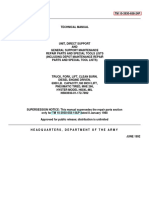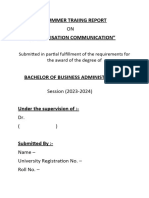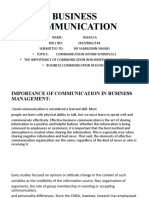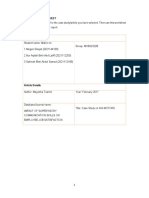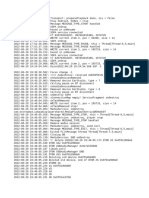Com 520 - Communication Guide
Com 520 - Communication Guide
Uploaded by
api-279315678Copyright:
Available Formats
Com 520 - Communication Guide
Com 520 - Communication Guide
Uploaded by
api-279315678Original Title
Copyright
Available Formats
Share this document
Did you find this document useful?
Is this content inappropriate?
Copyright:
Available Formats
Com 520 - Communication Guide
Com 520 - Communication Guide
Uploaded by
api-279315678Copyright:
Available Formats
EFFECTIVE COMMUNICATION GUIDE- TEAM D
Five Fundamentals for Effective Communication
David Fuller, Diane Harrell, LaToya Hemphill
COM/520
October 13, 2014
Dr. Jody Newman
EFFECTIVE COMMUNICATION GUIDE- TEAM D
Five Fundamentals of Effective Communication
Effective communication is a crucial part of the professional business
environment both presenting as an individual, or as part of a collective. With industries
progressively moving away from a top-down communication dynamic (with all decisions
coming from one person and being divided out to others in lower level positions), to a
more linear format which consist of a team of professionals within a company from
different divisions and levels of authority collaborating together for the purpose of
gaining a fresher perspective on industry issues. With this new teamwork model
becoming more of the norm it can be a difficult format to adjust to for both professionals
that are established in their position and may possess years of experience, to someone
that is just starting out in their career, and may be intimidated and insecure in their role
in the team. While there are a variety of communication factors to consider in
establishing a cohesive and productive team atmosphere, in reviewing communication
criteria, this guide will focus on five particular criteria points to incorporate into a
communication structure for positive outcomes. The focal points of this communication
guide are structured around being audience centered, incorporating strong clarity,
adhering to ethical business practices, encouraging engaged leadership, and
establishing the best communication channels for the team, and their purpose in the
group. We will review some of the pitfalls that professionals can encounter working in
teams, and some of the best practices of our chosen criteria.
EFFECTIVE COMMUNICATION GUIDE- TEAM D
Organizational Communication
Organizational communication relies on a collective or individual for reaching a
project goal. One of the main barriers to effective organizational communication is
when a creator of a message does not fully understand and respect the audience for
which a message is intended. Crafting messages using the you attitude, (Thill and
Bovee, 2013), requires a sender of a communication to learn as much as possible about
the biases of the audience. Age, ethnicity, gender, work and education history, as well
as the personal and professional needs of the intended receiver, must be taken into
account in order to create messages that the audience will deem beneficial to them. An
organization must use this audience-centered approach when crafting communication to
overcome misunderstandings attributed to these various biases and ensure audiences
will decode messages in the intended manner. Having an intimate knowledge of the
audience is required in choosing the most effective message a clear understanding of
your target audience and the audiences preferences will provide for the most effective
communication. (Berkes, 2008). In todays global workplace environment, this is even
more essential. Audiences today are more diverse. Whether communicating with
internal employees, or external customers, members of an organization must account
for varied cultural biases in their communications. Limiting slang, humor and other
cultural references will decrease the chance of misunderstandings during
communication with an ethnically diverse audience.
Some barriers to effective organization from the standpoint of maintaining a clear
and ethical communication structure, is that professionals should instill a level of self-
EFFECTIVE COMMUNICATION GUIDE- TEAM D
awareness in their business practices. A team lead or member of a project who has a
habit of being long-winded or over expounding on topics, would greatly benefit by
examining their personal communication style, and the effects that it might have on their
audience and team members. For the sake of clarity, a talkative professional should be
more thoughtful in their editing, both in verbal and written form. Schrodt, Witt, Turman,
Myers, Barton, and Jernberg (2009) note in their study how the communication
credibility of a mediator can have powerful effects on the comprehension of those they
work with. The same results can be expressed from an ethical perspective, should a
team member make a point of acknowledging their higher management level when
communicating with others. Peters, Lau, and Ngs (2014) study shows how
communicating to a group how much individual influence they have can sway support of
a project or be used as a form of general intimidation.
Technology has become a staple in every industry from small business to
Fortune 500 companies, and with the addition of social media, and the advancements in
videoconferencing through Skype, communication between individuals and industries
on a global level has become more accessible. However, leaders who are engaged in
effective organizational communication need the skill of developing relationships. The
art of listening, and giving and receiving feedback face to face, is an essential
leadership skill. Newspaper columnist David Conrad writes that technology can create
barriers to communication in the workplace. By using technology such email, texting,
video conferencing and social media, communication has become less personal and
more likely to be misunderstood (Conrad, 2014). Conrad demonstrates how managers
who are effective communicators are less dependent on electronic media. One method
EFFECTIVE COMMUNICATION GUIDE- TEAM D
he discusses in his column is called Management by Walking Around. Managers need
to get out of the office, walk around among their employees, ask questions and be
available to help when needed. Employees who see their leaders are approachable are
more likely to talk about issues before they become problems. When managers foster
trust among employees there is less chance of misinformation and communication
barriers. Successfully engaged leaders teach good communication skills by modeling
and training. Conrad (2014) explains in his column that leaders must be able to
generate enthusiasm in their teams, promote change in positive ways, motivate,
persuade, and build team relationships. Managers need to use information technology
skillfully to develop effective and persuasive presentations. They need to know how to
open dialog, promote positive interactions, and resolve conflicts. In addition, managers
need to encourage their team to develop strong and effective personal communications
skills through training and coaching (Conrad, 2014).
Ethical dilemmas can effect both internal and external performance. According to
Peters, Lau, and Ng (2014) one of the main factors affecting behavior of employees is
the role that managers play within the organizational climate. From the standpoint of
the team leader the best approach would be to address and review the companies code
of ethics at the beginning of a project to both establish that all members of the team
have been made aware of what will and will not be condoned and establishing a
baseline for what measures can be taken both during the brainstorming phase and
actual promotion of the project.
EFFECTIVE COMMUNICATION GUIDE- TEAM D
For members to effectively communicate within an organization or to outside
stakeholders, proper channels must be in place for individuals to connect. This
network must allow for the efficient and timely transfer of information to those within and
outside of an organization as well as have the means to encompass upward, downward
and horizontal communication and may be combined with evolving social
communication networks. Without an operating channel that connects all individuals
affecting an organization, effective communication cannot take place.
The globalization of the workplace has brought an ever increasing number of
communication channels to todays organizations. Social media channels can be
beneficial for an organization to efficiently and instantaneously communicate across a
wide audience. In order to effectively communicate with the various stakeholders
present on these channels, an organization must have rules governing the use of these
channels by employees. Preventing the posting of sensitive organizational information
and monitoring the flow of messages concerning the organization are all paramount in
avoiding damage to the organizations reputation or standing in the marketplace
Problem Solving Through Organizational Communication
Ed Robertson (2005) describes an organizational communications model
developed at Federal Express that places leadership right at the heart of the
communications process within an organization. Managerial Communication Climate
and Competence (MCC) redirects the emphasis of management from producers of
information to managers of communication processes, giving managers responsibility
for the flow of communication within the company. These managers are trained to
analyze how well communication is working, recognize the outcomes that indicate an
EFFECTIVE COMMUNICATION GUIDE- TEAM D
effective communication process, discover ways to make it work better, and accept
accountability for building a climate of open communication. The manner of
communicating information is just as important as the information content. Managers
are trained to communicate in a supportive manner that builds up the team and
communicates affirmation. Too often information can be delivered in a way that
demeans and tears down relationships. Managers accept responsibility for identifying
and removing obstacles to information sharing. (Robertson, 2005) Establishing a clear
line of communication can cut down on misunderstanding, both in delegating team
assignments and making sure that members are fully aware of their individual roles, and
also making sure that the end result of the team project is coherent to an audience
regardless of their professional backgrounds.
The audience centered approach impacts how effective an organization
addresses problems. Business problems affect individuals differently. In order to have
audiences respond and act towards resolving an issue, the creator of a message needs
to understand the impact this issue has on the audience. Information rich
communication channels are the most effective in allowing an organization to
communicate and resolve problems. These channels, including face to face
discussions and the introduction of video meetings, allow the audience to receive both
verbal and non-verbal messages including facial expressions, body language, tone and
volume of voice. These channels facilitate listening, allow for instant feedback and
discussion necessary for effective problem solving (Men, 2014).
EFFECTIVE COMMUNICATION GUIDE- TEAM D
Depending on the behavior and presence of the team leader can either enhance
or reduce credibility in the minds of the team collective (Schrodt, Witt, Turman, Myers,
Barton and Jernberg, 2009). Even in a team dynamic, if there is an established leader,
the others will look to the lead to establish the focus of the team and what those chosen
for the team will bring to the project. If the team members feel that the lead is not fully
invested or is not able to provide concrete information about a goal, then interest from
the group can begin to wane.
Addressing Business Issues Through Effective Communication
According to Bang, Fuglesang, Ovensen and Eilertsen (2010), establishing a
clear goal and keeping the discussion on topic strengthens the relationship between
team members and suppresses competing interest. A thorough understanding of an
organizations goals and objectives is paramount to its success. The communication of
an organizations vision has been found to be directly related to the effectiveness that
communication. (Sethi, and Adhikari, 2012). Using the audience centered approach
allows an organization to ensure each employee can understand these goals and
objectives after understanding their personal biases and needs. When communicating
a vision, an organization not only wants their members to understand its vision but also
to communicate it to others. (Cartwright, Talula, Baldwin, and David, 2006). For this
communication to have the most impact, it must be transferred through channels that
allow employees to become engaged in two way communication so questions can be
answered, employees can voice opinions and misunderstandings can be resolved in a
timely manner. These same channels, such as face to face discussions, employee
roundtables and internal company social media can also be used to survey employees
EFFECTIVE COMMUNICATION GUIDE- TEAM D
to evaluate the success of this message. When employees have this chance to voice
opinions and feel the organization considers their perspective, they can be more
satisfied in their relationship with the organization (Men, 2014).
The way leadership communicates an issue to employees has a major impact on
reaching a companys goals and objectives. DAprix and Cheryl (2006) describe the
communication process necessary to succeed in making a culture change within a
company. Organizational leadership is responsible for teaching the organization how to
communicate effectively in four critical areas. First, leaders must communicate why
change is necessary in a way that expresses their understanding of how this change will
impact employees. Second, leaders need to establish a plot line describing step by
step how the change will happen, what effect it will have on the workforce, what the
desired outcomes will be and how those outcomes will affect both employees and the
organization itself. Third, leaders need to know the people involved in the change
through two-way communication, soliciting feedback, and helping employees to take
ownership of the change. Finally, leaders and middle managers need to be engaged in
the change themselves, constantly monitoring the process, refining the plan, and
reporting on the positive impact.
The establishment of trust in a group allows team members to feel open in
sharing ideas even though they may be uncomfortable with the thought of being
critiqued, but when there is a sense of trust, members are likely to be more constructive
with their critique. As noted by George, Jones, and Harvey (2014), organizations and
professional bodies are responsible for the preparation of the conduct of the team. A
EFFECTIVE COMMUNICATION GUIDE- TEAM D
10
good team lead should not only be diligent in checking in with the group they are
responsible for, but also being mindful of checking in with the team and their
perspectives on their involvement in the project. Being assigned as a team leader
automatically put an individual in the center of everything related to the completed
project and also in the eyes of the collective give the assumption that the team leader
has all the answers. Whether valid or not, the team lead holds power over the group
and can dictate the course of the project without any input of the other members should
the lead take an unethical route in their management.
Managing Business Relationships Through Effective Communications
Business relationships are developed through communication. Whether it is
through conversations, speeches and presentations, or printed media, these
relationships are impacted by the messages we create and deliver. Knowing the
audience and how they may respond to these messages will affect how the message is
received. Individuals creating these relationships in an organization must use this
audience-centered approach since having an intimate knowledge and a clear
understanding of your target audience and the audiences preferences will provide for
the most effective communication. (Berkes, 2008).
Storytelling is replacing PowerPoint presentations as the most effective way of
communicating business strategy. A good anecdote or illustration can engage the
audience emotionally and help them retain more information. Stories provide practical
application of the idea or concept presented. A skilled storyteller is persuasive and able
to enhance the listeners comprehension and acceptance of information.
EFFECTIVE COMMUNICATION GUIDE- TEAM D
11
Maintaining and managing relationships within an organization relies on the
effective use of various communication channels. Channels such as face to face
conversations, email, video conferences, instant messenger, newsletters and the host of
available social media, all have various levels of media richness. Channels that are
considered media rich such as face to face conversations or video chats, have the
added level of non-verbal cues that add to an audience understanding a message.
Using a mixture of media richness within an organization adds to the level of
effectiveness. Employees typically show a higher level of satisfaction when
communication about their job or concerning their work performance was received
through a media rich channel, whereas information concerning the company itself was
better received through media lean channels (Byrne, and LeMay (2006). In a time of
constant updating of news and instant messages, using a combination of various
communication channels is the most effective means for an organization to maintain
relationships and the exchange of information.
Conclusion
In closing, based on both the studies of a variety of professionals and the
combination of our own career backgrounds and experiences, we feel confident that an
organization would strongly benefit by incorporating our chosen communication criteria.
EFFECTIVE COMMUNICATION GUIDE- TEAM D
12
References
Bang, H., Fuglesang, S., Ovesen, R. & Eilertsen, D. (2010). Effectiveness in top
management group meetings: The role of goal clarity, focused communication, and
learning behavior. Scandinavian Journal of Psychology, 51, 253-261.
doi:10.1111/j.1467-9450.2009.00769.x
Bonny, E., Berkes, F. (2008). Communicating traditional environmental
knowledge: addressing the diversity of knowledge, audiences and media types. Polar
Record, ISSN 0032-2474, 07/2008, Volume 44, Issue 3, pp. 243 253.
Byrne, Z., LeMay, E. (2006). Different media for organizational communication:
Perceptions of quality and satisfaction. Journal of Business and Psychology, 21, 149173.
Cartwright, Talula, Baldwin, David (2006) Communicating Your Vision.
Greensboro, NC, USA: Center for Creative Leadership, 2006. ProQuest ebrary. Web. 12
October 2014.
Conrad, D. (2014). Workplace communication problems: Inquiries by employees
and applicable solutions. Journal of Business Studies Quarterly, 5(4), 105-116.
Retrieved from http://search.proquest.com/docview/1542023353?accountid=35812
DAprix, R., & Cheryl, F. T (2006). Four essential ingredients for transforming
culture. Strategic Communication Management, 10(3), 22-25. Retrieved from
http://searchproquest.com/docview/203600122?accounid=35812.
George, G., Jones, A., Harvey, J. (July, 2014). Analysis of the language used
within codes of ethical conduct. Journal of Academic and Business Ethics, 8, 1-24.
Retrieved from http://search.proquest.com/docview/1554602986?accountid=458
EFFECTIVE COMMUNICATION GUIDE- TEAM D
13
Men, L (2014) Strategic Internal Communication: Transformational Leadership
Communication Channels, and Employee Satisfaction. Management Communication
Quarterly, ISSN 0893-3189, 05/2014, Volume 28, Issue 2, pp. 264 284.
Peters, S., Lau, T., Ng, C. (July, 2014), Determinants of Job Satisfaction and
Ethical Behavior towards Organizational Commitment A Review. International Journal
of Academic Research in Business and Social Sciences, 4(7), 573-591. doi:
10.6007/IJARBSS/v4-i7/1052
Robertson, E. (2005). Placing leaders at the heart of organizational
communication. Strategic Communication Management, 9(5), 34-37. Retrieved from
http://search.proquest.com/docview/203576150?accountid=35812
Schrodt, P., Witt, P., Turman, P., Barton, M., Jernberg, K. ( July, 2009). Instructor
Credibility as a Mediator or Instructors Prosocial Communication Behaviors and
Students Learning Outcomes. Communication Education, 58(3), 350-371. doi:
10.1080/03634520902926851
Sethi, A., & Adhikari, B. (2012). Impact of communicating 'vision'on organizational
communication effectiveness. International Journal of Marketing & Business
Communication, 1(3), 43-48. Retrieved from
http://search.proquest.com/docview/1478016334?accountid=458
Thill, V., & Bove, C., (2013). Excellence in Business Communication (10th ed.).
Upper Saddle River, NJ: Pearson Education.
You might also like
- Hyster H 60 XL SHOP MANUALDocument273 pagesHyster H 60 XL SHOP MANUALjacksonholland833586% (7)
- Research Proposal-Organization CommunicationDocument13 pagesResearch Proposal-Organization CommunicationParameswary Retnam83% (6)
- PT6T36Document234 pagesPT6T36thomas100% (3)
- Amul Final ReportDocument47 pagesAmul Final Reportavinash tripathi100% (6)
- INTERPERSONAL AND ORGANIZATIONAL CommDocument14 pagesINTERPERSONAL AND ORGANIZATIONAL CommGeejay aleman100% (1)
- Group B Assignment for Mrs. Saidu TERM PAPERDocument11 pagesGroup B Assignment for Mrs. Saidu TERM PAPERjenebavonu2005No ratings yet
- Effective Organizational CommunicationDocument18 pagesEffective Organizational CommunicationEdril MenezesNo ratings yet
- Organizational Communications Audits Asseessing Core Communications Competencies Within OrganizationsDocument13 pagesOrganizational Communications Audits Asseessing Core Communications Competencies Within OrganizationsroyNo ratings yet
- Problems of CommunicationDocument7 pagesProblems of CommunicationCarlos Pedro MacuácuaNo ratings yet
- 1Document16 pages1Pure Master's AcademyNo ratings yet
- Communication Skills Notes-3-1Document36 pagesCommunication Skills Notes-3-1bensonorika38No ratings yet
- Leadership Communication: A Communication Approach For Senior-Level Managers by Deborah J. Barrett Rice University, Houston, TexasDocument9 pagesLeadership Communication: A Communication Approach For Senior-Level Managers by Deborah J. Barrett Rice University, Houston, TexassonuprasadNo ratings yet
- The Impact of Communication On OrganisatDocument12 pagesThe Impact of Communication On Organisatewrerwrew100% (1)
- Leadership Communication - A Communication Approach For Senior-Level Managers - BarrettDocument17 pagesLeadership Communication - A Communication Approach For Senior-Level Managers - BarrettAnshuman MishraNo ratings yet
- MBA Assignment NIBMDocument48 pagesMBA Assignment NIBMimran abdul azizNo ratings yet
- Communication StrategyDocument29 pagesCommunication StrategyesangmichelleudofiaNo ratings yet
- BCR Report by Jahnavi GrampurohitDocument10 pagesBCR Report by Jahnavi Grampurohitshreeshhebbar67No ratings yet
- Employee Communication - Factsheets - CIPDDocument6 pagesEmployee Communication - Factsheets - CIPDFlorin IstratoiuNo ratings yet
- Managing Organizational CommunicationDocument9 pagesManaging Organizational CommunicationBeatriz VidalNo ratings yet
- Communication Styles in The WorkplaceDocument12 pagesCommunication Styles in The WorkplaceRikky AbdulNo ratings yet
- BC 3 AssignmentDocument15 pagesBC 3 AssignmentSreyas SairamNo ratings yet
- Capco Case Study, Amateur AnalysisDocument21 pagesCapco Case Study, Amateur AnalysisMohd Nasrul Hakim SallehudinNo ratings yet
- Clarify The Idea Before CommunicationDocument8 pagesClarify The Idea Before CommunicationYusuf MonafNo ratings yet
- Business EnglishDocument10 pagesBusiness EnglishANDRIATAHINANo ratings yet
- Goal of Business CommunicationDocument18 pagesGoal of Business CommunicationNeilson GodfreyNo ratings yet
- Chapter:01 Introduction To Report: - Establish Open Communication ChannelsDocument62 pagesChapter:01 Introduction To Report: - Establish Open Communication Channelskanth9873No ratings yet
- Definition Organizational CommunicationDocument10 pagesDefinition Organizational CommunicationErrik MaulanaNo ratings yet
- MT123 Business CommunicationDocument22 pagesMT123 Business CommunicationShantanu JahagirdarNo ratings yet
- Success Through CommunicationDocument3 pagesSuccess Through CommunicationElvin TagalogNo ratings yet
- ReportDocument25 pagesReportmalikrekha900No ratings yet
- Communication SkillsDocument27 pagesCommunication Skillsharsh7777No ratings yet
- Research Proposal REVISED VERSIONDocument20 pagesResearch Proposal REVISED VERSIONJudith MalveauxNo ratings yet
- STRONG BUSINESS COMMUNICATION AssignmentDocument7 pagesSTRONG BUSINESS COMMUNICATION Assignmentchinkhota2018No ratings yet
- Bege-145 Solve AssignmentDocument10 pagesBege-145 Solve Assignmentddpratibha raiNo ratings yet
- Contemporary Business Communication AssignmentDocument13 pagesContemporary Business Communication Assignmentttesfaye437No ratings yet
- Submitted by Nandhaharish.N 35024 Kannadhasan.M 35076 Siva.K 35094 Sreyas Sairam 35095 Yugeash Kumar - SM 35113Document15 pagesSubmitted by Nandhaharish.N 35024 Kannadhasan.M 35076 Siva.K 35094 Sreyas Sairam 35095 Yugeash Kumar - SM 35113Sreyas SairamNo ratings yet
- Comm Skill Assignment 3Document7 pagesComm Skill Assignment 3Samud MorrisNo ratings yet
- APY 3202 Reflection Chapter11Document2 pagesAPY 3202 Reflection Chapter11JOANAFELIZ ROXASNo ratings yet
- Jasmine Agcaoili Reflection Paper Soft Skills TrainingDocument3 pagesJasmine Agcaoili Reflection Paper Soft Skills TrainingJam GarciaNo ratings yet
- Journal 1 CommunicationDocument1 pageJournal 1 Communicationnutipatel99No ratings yet
- The Role of CommunicationDocument10 pagesThe Role of CommunicationMiguelNo ratings yet
- BA 213 - Reflection Paper Topic 6Document1 pageBA 213 - Reflection Paper Topic 6Mary TonacaoNo ratings yet
- Mastersreport PortfolioDocument32 pagesMastersreport Portfolioapi-308573468No ratings yet
- Thesis On Organizational CommunicationDocument7 pagesThesis On Organizational Communicationdwf6nx2z100% (2)
- Priya 2Document36 pagesPriya 2gudiyaprajapati825No ratings yet
- DQ 5Document3 pagesDQ 5GS々DEVIL NeeruttarNo ratings yet
- PHRI Mod 3Document69 pagesPHRI Mod 3mostey mostey100% (1)
- Business CommunicationDocument11 pagesBusiness CommunicationRaheela AliNo ratings yet
- Research MemoDocument6 pagesResearch Memoapi-285499856100% (1)
- Report Writing On Business CommunicationDocument11 pagesReport Writing On Business CommunicationCarelessly CarefulNo ratings yet
- Corporate CommunicationDocument9 pagesCorporate CommunicationSingaraju SarathNo ratings yet
- Mumbai Speech - Internal CommunicationsDocument14 pagesMumbai Speech - Internal CommunicationsSi Nguyen QuocNo ratings yet
- CICRMA CommunicationDocument23 pagesCICRMA CommunicationManeta Linnys DzaumaNo ratings yet
- Asm453 2Document10 pagesAsm453 2Megan Sikajat100% (1)
- Enhancing Middle Management - The Key To Effective Workplace Communication SkillsDocument6 pagesEnhancing Middle Management - The Key To Effective Workplace Communication SkillsNguyen Xuan Duong (FGW HCM)No ratings yet
- Barriers On Effective CommunicationDocument22 pagesBarriers On Effective CommunicationSehar IrfanNo ratings yet
- 5007-2..... Roll No 3Document18 pages5007-2..... Roll No 3Noaman AkbarNo ratings yet
- Chapter 01 Intro To BCDocument32 pagesChapter 01 Intro To BCAbhinav SuneethNo ratings yet
- INTERP1Document14 pagesINTERP1Dr. Doaa El MorsiNo ratings yet
- Unit 1 Communication in The Work PlaceDocument27 pagesUnit 1 Communication in The Work PlaceParthiban PartNo ratings yet
- Chapter 7 PurcomDocument22 pagesChapter 7 PurcomYesha Jade SaturiusNo ratings yet
- Latoya D. Hemphill, M.A.Ed.: ObjectivesDocument3 pagesLatoya D. Hemphill, M.A.Ed.: Objectivesapi-279315678No ratings yet
- Lhemphill Synchronous 3-Day Model - IntroDocument3 pagesLhemphill Synchronous 3-Day Model - Introapi-279315678No ratings yet
- Aet 552 Marketing Plan PresentationDocument13 pagesAet 552 Marketing Plan Presentationapi-279315678100% (1)
- Cur 518 Organization Diveristy Planning PresentationDocument10 pagesCur 518 Organization Diveristy Planning Presentationapi-279315678No ratings yet
- Aet 508 The Future of Community-Based Services and EducationDocument6 pagesAet 508 The Future of Community-Based Services and Educationapi-279315678No ratings yet
- Book2Document1 pageBook2api-279315678No ratings yet
- Book 1Document1 pageBook 1api-279315678No ratings yet
- Ignition System 1. General: Engine - 2Tr-Fe Engine EG-24Document2 pagesIgnition System 1. General: Engine - 2Tr-Fe Engine EG-24Maxi SardiNo ratings yet
- A Perpetual LightDocument7 pagesA Perpetual Lightsuherlan endan100% (1)
- As-1 Disclosure of Accounting PoliciesDocument7 pagesAs-1 Disclosure of Accounting PoliciesPrakash_Tandon_583No ratings yet
- Determination of Efficiency of Flat-Plate Solar Collectors Using Neural Network ApproachDocument7 pagesDetermination of Efficiency of Flat-Plate Solar Collectors Using Neural Network ApproachOmarZSharafNo ratings yet
- Marketing PlanDocument19 pagesMarketing PlanDo NotNo ratings yet
- Insurance LawDocument24 pagesInsurance Lawfekadu bayisa100% (1)
- UAPPDocument91 pagesUAPPMassimiliano de StellaNo ratings yet
- 123 Impact of Family Pressure To The Academic Performance of StudentsDocument29 pages123 Impact of Family Pressure To The Academic Performance of StudentsJeneffer Estal Fraga100% (1)
- Fem HSMDocument29 pagesFem HSMVishwajith ShettyNo ratings yet
- Drilling SpoolDocument2 pagesDrilling SpoolCarlos Sarmiento CalderónNo ratings yet
- M.A. (Part - I) History Paper - III - History of Europe (1789-1919) - (Eng) PDFDocument254 pagesM.A. (Part - I) History Paper - III - History of Europe (1789-1919) - (Eng) PDFSachin Saraswati67% (3)
- 2.3 Reading XedDocument4 pages2.3 Reading Xedabdulkhan3469784No ratings yet
- Aokly 300ah GelDocument2 pagesAokly 300ah GelYesibeth MartinezNo ratings yet
- Behringer B2031 ΗχειαDocument4 pagesBehringer B2031 ΗχειαevmolposNo ratings yet
- Trade Finance PracticalDocument383 pagesTrade Finance PracticalSuvankar NandiNo ratings yet
- PR1 L4Document43 pagesPR1 L4Garie PanganibanNo ratings yet
- Ees 6.8-1 Hard Chrome PlatingDocument5 pagesEes 6.8-1 Hard Chrome PlatingRobyn NashNo ratings yet
- Sans1418 1Document13 pagesSans1418 1nyala chisolaNo ratings yet
- Antioxidante (BHT)Document3 pagesAntioxidante (BHT)Frank Otihua LaosNo ratings yet
- Return To Play Rugby VictoriaDocument13 pagesReturn To Play Rugby VictoriaTonyNo ratings yet
- Design For NSF by Harry PoulosDocument7 pagesDesign For NSF by Harry PoulosSantosoNo ratings yet
- Skipper LTD (1) - Ventura ResearchDocument19 pagesSkipper LTD (1) - Ventura ResearchS GNo ratings yet
- Worksheet Real EstateDocument4 pagesWorksheet Real EstatesevaNo ratings yet
- Safal Project DocumentDocument64 pagesSafal Project DocumentAlok Khuntia100% (1)
- HBK Ncode DesignLife Brochure WebDocument8 pagesHBK Ncode DesignLife Brochure WebMajid Rezazadeh R.No ratings yet
- Sandra Goldstein ResumeDocument1 pageSandra Goldstein Resumeapi-403047209No ratings yet
